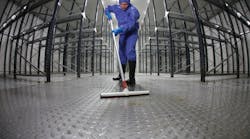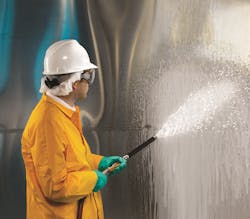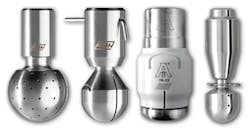One of the scariest problems for food production is allergen contamination. There are many consumers for whom one bite or sip of the wrong product brings serious, even fatal consequences.
Food allergies trigger 30,000 emergency room visits a year and cause up to 200 deaths, according to federal statistics. The stakes are higher with the addition, effective Jan. 1, of sesame to the FDA’s list of allergens that must be declared on labels.
If a plant runs products that contain allergens, and these vary from product to product – present in some but not in others – then cross-contamination is a major concern. Even traces of allergens can induce reactions, which takes concerns over cleaning and sanitation to a new level. Momentary carelessness in cleaning can result in contamination that’s hard to detect and potentially fatal.
If allergen contamination is an issue, it’s important to build a cleaning plan around that. The first step is an assessment of what is at stake: which allergens are present, when and how they’re used, how they’re stored, etc. If possible, they should be stored separately, in an enclosed area. Specific tools – including mundane things like brooms and brushes, ideally color-coded – should be designated for use with allergens alone.
The type of allergens must also be taken into account. Liquids or sticky substances, like peanut butter, pose different risks and need different procedures than solid particulates like sesame seeds.
Cleaning procedures should be put in writing and available to the cleaning staff, says Bret Zaher, manager at AIB International. As with most cleaning procedures, the first step should be the removal of all visible debris and residue before in-depth cleaning starts. That should be done with rinsing, for lines where wet cleaning is acceptable, and brushing/vacuuming for dry cleaning.
Beware of hot spots
“Another important aspect during cleaning is knowing the equipment and specific ‘hot spots’ for product residue build-up,” Zaher says. “These areas include rollers, scrapers, elbows, tensioners and product guides, to name a few.”
Much modern food processing equipment is designed to be relatively easy to clean. But equipment that is older or not as well designed might have crevices, recesses, protrusions or other elements where filth – including allergenic residue – can accumulate.
“The first thing you want to do is look at those spots that might be needing quick fixes,” Evan Reyes, director of sales for the sanitation division of Goodway Technologies, said in an Oct. 12 Food Processing webinar. “Are there areas that are challenging to access? Maybe guide rails underneath conveyor belts, or hollow areas on framework? Can we eliminate those? Can we create sloped surfaces instead of flat surfaces? Can we weld some of that stainless steel to eliminate cracks? Just trying to eliminate as many points of contamination as we can.”
There are certain basics that should be built into every cleaning plan. “Although cleaning demands, either in-place or out-of-place, vary based on soils, equipment, and operations, the basic elements of proper time, action, chemical and temperature (TACT) are essential,” says Bryan Downer, vice president of sales and marketing for Sani-Matic.
What to clean with?
The choice of cleaning chemicals is dictated by the nature of the allergens to be removed. “Most allergens are proteins; therefore, cleaning chemistries that target proteins are the most effective in removing allergens,” says Jeremy Adler, senior program lead for food safety at Ecolab. This means they usually should have an oxidizing agent like sodium hypochlorite or hydrogen peroxide. (The latter can also be used for pretreatment.)
The simple tools of cleaning need attention also. “Cleaning tools are regularly forgotten about during the cleaning process,” Zaher says. “Often, reusable brushes, scrapers and tools are used during the cleaning process, but there is no follow-up to ensure this cleaning equipment is being cleaned afterwards. This includes your utensil wash sinks and clean-out-of-place (COP) tanks.”
Simple accessibility of those tools is important; it doesn’t matter how clean they are if they don’t get used often enough.
“If all the tools are tidy and accessible and working, the chances are much greater that the operator will be able to use them throughout the day,” Reyes said during the webinar. “If it’s in a corner of the plant and it’s difficult to go get it, chances are it’s not going to be used all that much.”
CIP is no panacea
A lot of food equipment has clean-in-place capability. CIP is a fine way to keep equipment clean with minimal day-to-day effort, but processors should not think of it as a panacea that will solve all of their cross-contamination problems.“Cleaning-in-place does not assure allergens will be removed,” says Mitch Fay, technical director at Hydrite. “Processing equipment that is not regularly taken apart or inspected creates a difficult situation.” Certain kinds of equipment or components are especially problematic for CIP systems, including heat exchangers, separators, evaporators, valve clusters and gaskets.
A major potential issue is CIP components that are not properly maintained, or were not suited to the application in the first place. “The CIP system is designed to supply cleaning solution, but it is the work of the cleaning device in the tank to deliver that solution properly,” says Sani-Matic’s Downer. “We regularly see equipment that have inadequate or improper cleaning devices installed, which creates cleaning issues or elongated cleaning times.”
Clogs in spray balls or in-line strainers, leaking pumps and other maintenance issues can compromise CIP effectiveness, at least to the degree required to remove allergen traces. This situation is often exacerbated because components in inaccessible places, like spray balls inside tanks, may only be inspected a few times a year.
How dry I am
Allergen removal poses a special challenge for plants that do entirely dry processing, such as blending powders. Washing down equipment with massive amounts of water is simply not an option for such operations; they can’t risk even traces of moisture migrating into the product.
“Dry products have traditionally been dry-cleaned, as the presence of water creates potential issues,” Downer says. “However, allergens are a chemical, not a biological contaminant, and therefore cannot always be eliminated by dry cleaning.”
Dry cleaning is usually done with brushes and vacuums. When cross-contamination prevention is required, the cleared surfaces must then be scrubbed and dried by hand ¬ a time-consuming process, especially if powder is caked onto a mixer’s paddles and interior surfaces.
Equipment is available that can speed things up. Tetra Pak offers the Air Jet Cleaning System for some of its dry mixers. Interior nozzles blow compressed air through the vessel, dislodging the powder residue, which can then be reclaimed and reworked (unlike residue removed by hand vacuums).
In most applications, enough of the residue gets removed so that personnel can finish the job by hand-swabbing the internal surfaces with an alcohol-based solution to remove allergen traces. This procedure can reduce cleaning time from 90 minutes to 30, according to JC Margotteau, Tetra Pak’s sales support manager for powder handling.
Cleaning to remove allergen cross-contamination requires a special effort that recognizes what’s at stake: prevention of what could be a catastrophe for vulnerable consumers.
Says AIB’s Zaher: “When it comes to allergen cleaning validation, it’s always best to go above and beyond the basic visual clean to help validate the program.”





